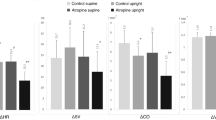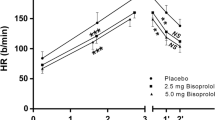Abstract
The aim of this study was to find out whether, in humans, the increase in vagal tone accompanying cardiac β-adrenoceptor (β-AR) stimulation might be different dependent on β1- or β2-AR stimulation.
For this purpose we studied, in six male healthy volunteers (aged 28±1 years), the effects of atropine infusion (0.15 μg/kg/min continuously) on increase in heart rate (HR) and contractility (determined as shortening of HR-corrected duration of electromechanical systole-QS2c) evoked by infusion of isoprenaline (3.5–35 ng/kg/min, increasing HR and QS2c via β1-and β2-AR), terbutaline (25–150 ng/kg/min, increasing HR and QS2c via β2-AR), adrenaline (20–160 ng/kg/min, increasing HR via β2- and QS2c via β1-AR) and bicycle exercise in supine position (increasing HR and QS2c via β1-AR). The three β-AR agonists and exercise increased HR and shortened QS2c in a dose- or work-load-dependent manner, respectively. Atropine enhanced HR-increasing effects of all three β-AR agonists and exercise; increases were larger for β2-AR (terbutaline, adrenaline) mediated effects than for β1-AR (exercise) mediated effects. Moreover, atropine enhanced β-AR agonists-induced QS2c shortening; however, atropine effects on QS2c were markedly less pronounced than on HR.
From the results we conclude that, in humans, β1-and β2-AR mediated stimulation evoked HR-increases are composed of two components: increases via direct β-AR stimulation and simultaneously decreases via increase in vagal tone. In addition, β-AR mediated increases in contractility are also dampened by simultaneous activation of vagal tone but to a lesser extent possibly because human ventricular myocardium is only sparsely parasympathetically innervated.





Similar content being viewed by others
References
Arnold JMO, McDevitt DG (1984) Vagal activity is increased during intravenous isoprenaline infusion in man. Br J Clin Pharmacol 18:311–316
Arnold JMO, O'Connor P, Riddell JG, Harron DWG, Shanks RG, McDevitt DG (1985) Effects of the β2-adrenoceptor antagonist ICI 118,551 on exercise tachycardia and isoprenaline-induced β-adrenoceptor responses in man. Br J Clin Pharmacol 19:619–630
Belz GG (1995) Systolic time intervals: a method to assess cardiovascular drug effects in humans. Eur J Clin Invest 25 [Suppl 1]:35–41
Belz GG, Matthews JH, Graf D, Stern HC, Bachmann R, Belz G, Steinijans VW, Palm D (1985) Dynamic responses to intravenous urapidil and dihydralazine in normal subjects. Clin Pharmacol Ther 37:48–54
Brodde O-E (1991) β1- and β2-adrenoceptors in the human heart: properties, function, and alterations in chronic heart failure. Pharmacol Rev 43:203–242
Brodde O-E, Michel MC (1999) Adrenergic and muscarinic receptors in the human heart. Pharmacol Rev 51:651–689
Brodde O-E, Konschak U, Becker K, Rüter F, Poller U, Jakubetz J, Radke J, Zerkowski H-R (1998) Cardiac muscarinic receptors decrease with age. In vitro and in vivo studies. J Clin Invest 101:471–478
Brown MJ, Brown DC, Murphy MB (1983) Hypokalemia from beta2-receptor stimulation by circulating adrenaline. N Engl J Med 309:1414–1419
Daul A, Hermes U, Schäfers RF, Wenzel R, von Birgelen C, Brodde O-E (1995) The β-adrenoceptor subtype(s) mediating adrenaline- and dobutamine-induced blood pressure and heart rate changes in healthy volunteers. Int J Clin Pharmacol Ther 32:140–148
Deighton NM, Motomura S, Borquez D, Zerkowski H-R, Doetsch N, Brodde O-E (1990) Muscarinic cholinoceptors in the human heart: demonstration, subclassification and distribution. Naunyn-Schmiedebergs Arch Pharmacol 341:14–21
Dhein S, Van Koppen CJ, Brodde O-E (2001) Muscarinic receptors in the mammalian heart. Pharmacol Res 44:161–182
Hakim K, Fischer M, Günniker M, Poenicke K, Zerkowski HR, Brodde O-E (1997) Functional role of β2-adrenoceptors in the transplanted human heart. J Cardiovasc Pharmacol 30:811–816
Hellgren I, Mustafa A, Riazi M, Suliman I, Sylven C, Adem A (2000) Muscarinic M3 receptor subtype gene expression in the human heart. Cell Mol Life Sci 57:175–180
Kent KM, Epstein SE, Cooper T, Jacobowitz DM (1974) Cholinergic innervation of the canine and human ventricular conducting system: anatomic and electrophysiologic correlations. Circulation 50:948–955
Krejci A, Tucek S (2002) Quantitation of mRNAs for M1 to M5 subtypes of muscarinic receptors in rat heart and brain cortex. Mol Pharmacol 61:1267–1272
Landzberg JS, Parker JD, Gauthier DF, Colucci WS (1994) Effect of intracoronary acetylcholine and atropine on basal and dobutamine-stimulated left ventricular contractility. Circulation 89:164–168
Leenen FHH, Chan YK, Smith DL, Reeves RA (1988) Epinephrine and left ventricular function in humans: effects of beta1 vs non-selective beta-blockade. Clin Pharmacol Ther 43:519–528
Levine MAH, Leenen FHH (1989) Role of β1-receptors and vagal tone in cardiac inotropic and chronotropic responses to a β2-agonist in humans. Circulation 79:107–115
Löffelholz K, Pappano AJ (1985) The parasympathetic neuroeffector junction of the heart. Pharmacol Rev 37:1–24
McDevitt DG (1989) In vivo studies of the function of β-adrenoceptors in man. Eur Heart J 10 [Suppl B]:22–28
Motomura S, Zerkowski H-R, Daul A, Brodde O-E (1990) On the physiologic role of beta2 adrenoceptors in the human heart: in vitro and in vivo studies. Am Heart J 119:608–619
Newton GE, Parker AB, Landzberg JS, Colucci WS, Parker JD (1996) Muscarinic receptor modulation of basal and β-adrenergic stimulated function of the failing human left ventricle. J Clin Invest 98:2756–2763
Oberhauser V, Schwertfeger E, Rutz T, Beyersdorf F, Rump LC (2001) Acetylcholine release in human heart atrium: influence of muscarinic autoreceptors, diabetes and age. Circulation 103:1638–1643
Poller U, Nedelka G, Radke J, Pönicke K, Brodde O-E (1997) Age-dependent changes in cardiac muscarinic receptor function in healthy volunteers. J Am Coll Cardiol 29:187–193
Schäfers RF, Adler S, Daul A, Zeitler G, Vogelsang M, Zerkowski H-R, Brodde O-E (1994) Positive inotropic effects of the beta2-adrenoceptor agonist terbutaline in the human heart: effects of long-term beta1-adrenoceptor antagonist treatment. J Am Coll Cardiol 23:1224–1233
Schäfers RF, Poller U, Pönicke K, Geissler M, Daul AE, Michel MC, Brodde O-E (1997) Influence of adrenoceptor and muscarinic receptor blockade on the cardiovascular effects of exogenous noradrenaline and of endogenous noradrenaline released by infused tyramine. Naunyn-Schmiedebergs Arch Pharmacol 355:239–249
Stern H, Matthews JH, Belz GG (1984) Influence of dihydralazine induced afterload reduction on systolic time intervals and echocardiography in healthy subjects. Br Heart J 52:435–439
Acknowledgement
This work was supported by a grant of the Deutsche Forschungsgemeinschaft Bonn/ Germany (DFG SFB 598–02 to O.-E.B.).
Author information
Authors and Affiliations
Corresponding author
Rights and permissions
About this article
Cite this article
Bruck, H., Ulrich, A., Gerlach, S. et al. Effects of atropine on human cardiac β1- and/ or β2-adrenoceptor stimulation. Naunyn-Schmiedeberg's Arch Pharmacol 367, 572–577 (2003). https://doi.org/10.1007/s00210-003-0757-9
Received:
Accepted:
Published:
Issue Date:
DOI: https://doi.org/10.1007/s00210-003-0757-9




